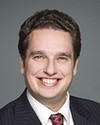Thank you, Mr. Chairman. It's nice to be back at the procedure and House affairs committee after a number of years of absence, and in a different capacity from when I was here as a member of the committee some years ago.
I'm pleased to be joined today by Marc Bosc, the acting Clerk of the House of Commons; Daniel Paquette, the chief financial officer; Chief Superintendent Michael Duheme, director of the Parliamentary Protective Service; and Sloane Mask, the deputy chief financial officer of the Parliamentary Protective Service, or PPS, as I'll call it.
I'll be presenting the House of Commons main estimates first, followed by those of the new PPS.
We're also joined by other members of the House administration's executive management team: Stéphan Aubé, the chief information officer; Philippe Dufresne, the law clerk and parliamentary counsel; André Gagnon, the acting deputy Clerk, procedural services; Benoit Giroux, director general, parliamentary precinct operations; Patrick McDonell, deputy Sergeant-at-Arms and corporate security officer; and Pierre Parent, the chief human resources officer.
You should all have a copy of the presentation, so I won't read it. I prefer to give you an overview, so as to leave more time for questions and answers.
I'll begin with the House of Commons main estimates for 2016-17, which total $464 million, an increase of 4.55% over 2015-16.
I'll provide an overview of the relevant line items in the main estimates along four major themes: budgets for members, House officers, and presiding officers; House administration; electoral boundary redistribution; and the PPS.
Let me begin with the budgets for members, House officers and presiding officers.
At its meeting of March 10, 2015, the Board of Internal Economy acknowledged an increase of 2.3%, effective April 1, 2015, to members' annual sessional allowance and additional salaries. This funding is statutory in nature and is in accordance with provisions in the Parliament of Canada Act. The increase amounts to $1.3 million for the 2016-2017 fiscal year and subsequent years.
In December 2015 the Board of Internal Economy approved a one-time increase of 20% to members' office budgets and to House officers' budgets. This comes after six years of these budgets being frozen, the last increase having occurred in 2009-10. Future adjustments will be based on the consumer price index as measured in September of the previous year.
There was also a one-time increase of 5% to the members' travel status expenses account.
Following the general election, the House officers' office budgets were established, based upon the election results for all parties in accordance with the long-standing formula approved by the board. The resulting funding increase of $1.1 million is being sought for 2016-17 and subsequent years.
I should also point out that members' statutory budgets were reduced by $5 million, due in part to savings generated through the individual and corporate flight pass programs.
Let's now look at House administration.
The first element is $3.4 million in funding for salaries of the House administration employees.
Several new and rehabilitated buildings that are part of the long-term vision and plan are opening in the coming years. This will require increased resources and funding. Two examples include the commissioning of the Sir John A. Macdonald Building, last September, and the upcoming commissioning of the Wellington Building, this fall. This funding of $5.6 million was approved for the 2016-2017 fiscal year.
With the opening of these buildings, additional funding is required for salary, operating, and capital expenses to ensure continued support of the building assets transferred from Public Services and Procurement Canada as they are completed. Unfortunately—before you ask—I don't have control of office allocation.



